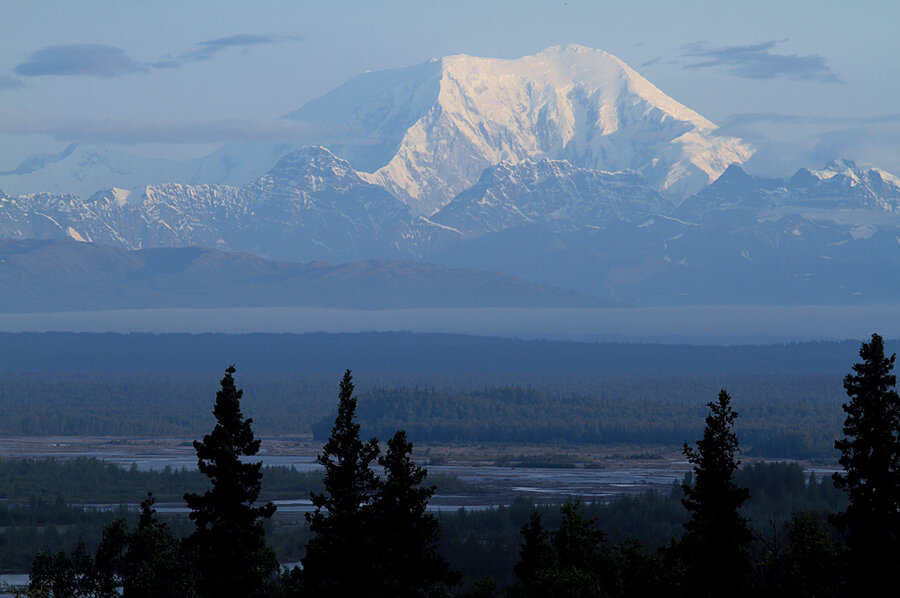Two sisters, two wildernesses
Loading...
We don't know where we're going, and we don't know how we are getting there.
This truth becomes ever more apparent as my sister Britta and I bushwhack through tangles of willow. We gouge our shins on immovable limbs, get clipped in the head by big branches, snag our packs on twigs. We have long extolled the virtues of the trail-less wilderness backcountry system of Alaska's Denali National Park: You are assigned a unit and can camp anywhere, as long as you are a half mile from the single park road and out of sight of the tourists peering from buses. Now, as the willow shrubs tower above our heads, the system seems a tiny bit less ideal. What a wonderful thing is a path! What a lovely idea, to have a preordained campsite!
It takes some persistence, but we muscle our way through the willows and stand on shaking legs on the other side, wheezing like animals.
I lift binoculars to my eyes and scan the riverbed below us, then pan up to the low green hills that flank the snowy ridges that extend from the backbone of the Alaska Range. I pretend to search for a campsite, but Britta knows better.
"Anything?" she asks with a pretense of concern. I press my lips together, give a terse shake of my head.
When in the backcountry, and perhaps in life in general, Britta and I fall into distinct roles, as befits our statuses as youngest and eldest siblings. She is laid back and phlegmatic; I am edgy and nervous. She is optimistic, whereas I tend to imagine worst-case scenarios. This is demonstrated by our respective bear shouts. She lowers her voice to a tenor growl and hollers, "Hey, bear!" I imagine not one but many bears and yell, "Hey, bears!"
This role distinction can be found in other backcountry behaviors. We own one camera and one pair of binoculars between the two of us. Britta invariably carries the camera while I wear the binoculars around my neck. As we hike, Britta stops to photograph the minutiae at her feet. She zooms in to focus on tiny lichen tendrils, the sweet curve of a purple monkshood flower, the way a raindrop nestles at the spidery center of a lupine leaf. I, on the other hand, pause frequently to search the terrain before us for bears, investigating every suspect shrub or golden fallen boulder. I do not have peace of mind until I know the coast is clear. I must look ahead always, planning routes, zooming in on what is just out of sight.
Britta and I are patient with each other. I wait while she takes 10 shots of a lichen. She hums under her breath while I check out distant lurking boulders. I rely on her close attention to detail to tell me what I miss while being "bearanoid," and she counts on me to alert her to any danger.
My scan of the terrain does yield a possibility. "Look," I say, and point to a faint line etched into the side of a hill before us: a caribou trail.
"Why do you go backcountry if you're so scared?" she asks me as we lurch from tussock to moss hump in a low wet meadow.
"I'm not that scared," I say.
She snorts and looks away.
We set our feet beside half-moon hoof indents in the dirt, follow the steep grassy ridge, and pitch our tent on old caribou ground. I take one last quick look through the door of the tent, then zip the nylon closed and tuck the binocs away.
The wind drives patters of ice and rain against the thin skin of the tent, and I curl into my sleeping bag. It is a relief to relax my vigilance. I can't see anything beyond the flimsy tent walls, that fogged eye of a window. Whatever is outside is beyond my control now.
In the morning, I don't know what I will find outside. The new day is like Christmas morning. I stretch in my sleeping bag and try to make the moment last. I savor the anticipation, a mixture of fear and expectation.
When my bladder wins, I crawl out of my sleeping bag and unzip the mesh door. It is for this moment that I go backcountry. Still inside my warm nest, yet eager for the wide world at my doorstep, whatever it may hold.







